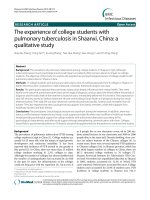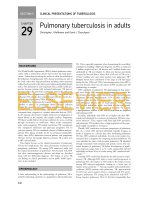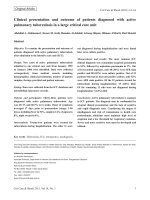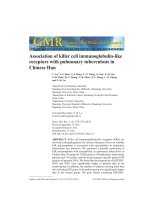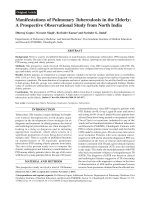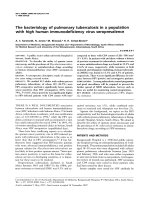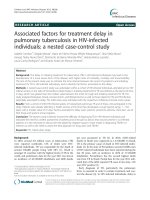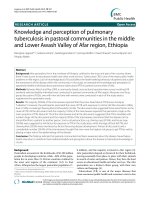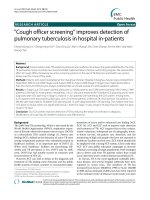Pulmonary Tuberculosis in Patients with HIV/AIDS in Iran pptx
Bạn đang xem bản rút gọn của tài liệu. Xem và tải ngay bản đầy đủ của tài liệu tại đây (6.78 MB, 7 trang )
Iranian J Publ Health, Vol. 40, No.1, 2011, pp.100-106 Original Article
Pulmonary Tuberculosis in Patients with HIV/AIDS in Iran
*A Hadadi
1
, P Tajik
2
, M Rasoolinejad
3
, S Davoudi
3
, M Mohraz
3
1
Dept. of Infectious Diseases, Sina Hospital, Iranian Research Center for HIV/AIDS, Tehran University of
Medical Sciences, Tehran, Iran
2
Dept. of Epidemiology & Biostatistics, School of Public Health, Tehran University of Medical Sciences,
Tehran, Iran
3
Dept. of Infectious Diseases, Research Center for HIV/AIDS, Imam Khomeini Hospital, Tehran University of
Medical Sciences, Tehran, Iran
(Received 5 Jul 2010; accepted 12 Feb 2011)
Introduction
“It is estimated that approximately one third of
the 40 million people living with Human Immu-
nodeficiency Virus (HIV) or Acquired Immune
Deficiency Syndrome (AIDS) worldwide are co
infected with TB” (1). The highest global rates
of TB/HIV co-infection are reported from sub-
Saharan Africa, Asia, and Latin America (More
than 95%) (2). HIV infection increases the risk
of developing active TB, either by the reactiva-
tion of a latent infection or the rapid progression
of a newly acquired infection; co-infection can
enhance HIV replication, thereby shortening sur-
vival and potentially enhancing HIV transmission
(3). The risk of the progression of infection into
active tuberculosis is 5-15% per year or 30%
during the lifetime period of the HIV positive pa-
tients compared to 5-10% lifetime risk in an im-
munocompetent host (4, 5). Available data shows
growing epidemics in several countries such as
Iran; the estimated number of people living with
HIV in Iran increased from 46000 in 2001 to
86000 in 2007 (6). In other words, tuberculosis,
with an annual incidence of 27/100,000 population
in 2004 is an endemic disease in Iran. It is also
estimated that HIV co-infection comprises 0.8%
of all TB cases in our country (7).
However, HIV-positive patients especially those
who are severely immunosuppressed are more likely
to have atypical and unique clinical and radio-
Abstract
Background: Pulmonary tuberculosis is still the most common form of tuberculosis in HIV infected patients having
different presentations according to the degree of immunosuppression. This study appraised the impact of HIV
infection on clinical, laboratory and radiological presentations of tuberculosis.
Methods: The clinical, laboratory and radiological presentations of pulmonary TB in 56 HIV-infected patients were
compared with 56 individually sex and age matched HIV-seronegative ones, admitted to Imam Hospital in Tehran
(1999-2006) using paired t-test in a case control study.
Results: All cases and the controls were male. Fever was found in 83.9% of the HIV positive patients compared to 80%
of the HIV negative ones. Cough was the most common clinical finding in the HIV negative group (89.3% vs. 82.1% in
HIV positive group). Among radiological features, cavitary lesions, upper lobe and bilateral pulmonary involvement
were observed significantly less often in the HIV-infected group. On the contrary, lymphadenopathy was just present in
the HIV positive group in this series of patients (12%) and primary pattern tuberculosis was more common, as well
(71% vs. 39%, P= 0.02). The Tuberculin test was reactive in 29% of the HIV/TB patients.
Conclusion: The coexistence of both infections alters the picture of tuberculosis in many aspects and should be taken
into account when considering a diagnosis of HIV infection and its potential for TB co-infection, and vice-versa.
Keywords: Pulmonary Tuberculosis, HIV, TB and HIV, Iran
*
Corresponding author:
Tel/Fax: +98 21 66348555, Email:
A Hadadi et al: Pulmonary Tuberculosis in Patients …
101
graphic features (3). Considering the increased
number of HIV/TB cases in the developing coun-
tries and the potential atypical presentations of this
group, special care, and attention should be pro-
vided for the timely diagnosis of TB in HIV po-
sitive patients.
The purpose of this study was to assess the dif-
ferences existent between HIV seropositive and
seronegative TB patients with regard to clinical and
laboratory features and radiographic appearance.
Materials and Methods
Imam hospital is the main referral teaching hos-
pital for HIV/AIDS patients in Iran. The records
of all patients with TB/HIV co-infection admitted
to the Infectious Disease Department of the hos-
pital from 1999 through 2006 were evaluated (n=
56). In this period, about 550 definite cases of
pulmonary TB without HIV infection were admit-
ted to the same department. From the admitted
cases, 56 were selected as pair-matched controls.
The matching factors were sex and age (±3 yr).
Pulmonary tuberculosis was defined in both groups
according to the WHO criteria; the definitions in-
clude one of the followings: a) two positive spu-
tum smears for acid-fast bacilli, b) one positive
sputum smear plus a positive sputum culture for
Mycobacterium tuberculosis, c) one positive spu-
tum culture plus radiological findings suggestive
for tuberculosis (8). The HIV seropositivity was
confirmed by at least two positive ELISA tests
followed by a positive western blot test as con-
firmations. In HIV positive patients, tuberculin skin
test ≥ 5 mm and in HIV negative patients, tu-
berculin skin test ≥ 10 mm were considered as
positive. The clinical presentations extracted from
the records were the presence of fever, weight
loss, sweating, fatigue, chronic cough, sputum and
respiratory distress. The laboratory findings in-
cluding the results of tuberculin skin test, Eryth-
rocyte Sedimentation Rate (ESR), hemoglobin
level, leukocyte, lymphocyte and CD4 cell count
(if available) were also reviewed. All chest X-rays
(CXR) were reviewed by one radiologist for infil-
tration, cavity formation, miliary pattern, fibrosis,
pleural effusion and hilar and/or mediastinal lym-
phadenopathy. The primary TB pattern was defined
as the presence of one of the following presenta-
tions: pleural effusion, lymphadenopathy, lower and
middle lobe infiltration and miliary pattern. Like-
wise, pulmonary fibrosis, cavity and apical involve-
ment were the indicators of secondary patterns.
The study protocol was approved by the Ethics
Committee of Tehran University of Medical Sci-
ences.
Statistics
The disease presentations were compared between
the pair-matches using paired t-test and Mantel-
Haenszel test for matched-pair strata; the odds
ratios (OR) and their 95% confidence interval (CI)
were calculated using this method. Unpaired com-
parisons were made using chi-squared test and
the independent sample Student’s t-test. The sta-
tistical analyses were performed using the SPSS
software version 16(SPSS Inc., Chicago, IL).
Results
In the present study, all cases were male. The
mean age of the patients in the HIV/TB group was
35.1±9.9 (range: 16-74) yr compared to 35.8±10.2
in the matched control group.
The most common clinical findings in the HIV+
group were fever and chronic cough (83.9% and
82.1%, respectively), while the most common
symptoms in the HIV negative group were chro-
nic cough (89.3%), weight loss (80.4%) and fever
(80%). Weight loss and sweating were more fre-
quently reported in the HIV negative group with
a statistically significant difference (80% vs. 50%,
P= 0.001 and 73% vs. 45%, P= 0.01, respectively).
Other clinical manifestations did not show any sig-
nificant differences between the two groups (Table
1). Among all the radiological patterns reviewed in
CXR, cavitation, upper lobe and bilateral involve-
ments were found to be significantly more common
in the HIV negative patients (34% vs. 9%; 59% vs.
21% and 42% vs. 21%, respectively). In contrast,
lymphadenopathy was only revealed in the HIV
positive group (12%); also, tuberculosis with the
Iranian J Publ Health, Vol. 40, No.1, 2011, pp.100-106
102
primary pattern was also reported to be more
common in the same group (71% vs. 39%). Al-
though some other features such as normal CXR
and pleural effusion were more frequent in the
HIV positive patients, the differences were not
statistically significant (Table 2).
Moreover, important laboratory findings were
studied in the two groups; 29% of the HIV posi-
tive patients and 42% of the HIV negative ones had
positive tuberculin skin test (OR= 0.56; 95%CI=
0.2-1.3; P= 0.23). The mean hemoglobin level
(11.6±2.5 g/dl vs. 12.3±2.1; P= 0.001) and the
mean WBC count (6113±3463/mm
3
vs. 8094±
4244; P= 0.001) were significantly lower in the
HIV positive patients. On the contrary, erythrocyte
sedimentation rate (ESR) was higher in HIV/TB
co-infected patients (78±31 mm/h) compared to
63±37 mm/h in the HIV negative (P= 0.02). To-
tal lymphocyte count (TLC), used in order to de-
termine the stage of HIV was less than 1200/mm
3
in 46.6% of the cases; this finding indicates sy-
mptomatic patients in advanced stages. CD4 count
was available for 28 patients with the median (in-
terqualtile range) of 181 (74.5–318.0) /mm
3
, among
which, 14 (50%) had CD4 count < 200 /mm
3
. As
shown in table 3,
there was no statistically sig-
nificant difference in the association between the
radiological features and patient category of CD4
count (CD4 count < 200 /mm3 vs. ≥ 200 /mm
3
) ex-
cept the bilateral lesions which were more fre-
quent among patients with CD4 count < 200/mm
3
.
Table 1: Clinical manifestations tuberculosis with and without HIV co-infection
Clinical Signs HIV+ n (%) HIV- n (%) OR (95%CI) P-value*
Fever 47 (83.9) 44 (80.0) 1.60 (0.5-4.9) 0.58
Weight loss 28 (50.0) 45 (80.4) 0.19 (0.06-0.5) 0.001
Sweating 25 (44.6) 41 (73.2) 0.38 (0.18-0.80) 0.012
Fatigue 30 (53.6) 38 (67.9) 0.56 (0.26-1.20) 0.18
Chronic cough 46 (82.1) 50 (89.3) 0.56 (0.19-1.66) 0.42
Sputum 40 (71.4) 41 (73.2) 0.90 (0.37-2.21) 1.00
Respiratory Distress 24 (42.9) 25 (47.2) 0.86 (0.40-1.85) 0.84
* Calculated by Mantel Haenszel test for matched – pair strata.
Table 2: Radiological manifestations tuberculosis with and without HIV co-infection in our study and other studies
Other studies (% in HIV+)
Clinical Signs
HIV+
n (%)
HIV-
n (%)
OR (95%CI) P-value *
Hong
5
Kong
(n=47)
Brazil
20
(n=60)
38 -
Cavitation 5 (8.9) 18 (33.8) 0.19 (0.05-0.64) 0.006 - -
Pleural Effusion 13 (23.2) 10 (18.2) 1.37 (0.55-3.40) 0.64 11 6
Normal CXR 10 (17.9) 4 (7.1) 2.50 (0.78-7.97) 0.18 8 -
Infiltration 25 (44.6) 30 (56.6) 0.61 (0.29-1.29) 0.26 - -
Miliary pattern 5 (8.9) 7 (12.7) 0.50 (0.12-2.00) 0.50 15 39
Lymphadenopathy 7 (12.5) 0 (0.0) - 0.023 - -
Fibrosis 1 (1.8) 6 (11.1) 0.17 (0.02-1.38) 0.13 - -
Upper lobe 12 (21.4) 32 (59.3) 0.20 (0.07-0.52) 0.001 36 -
Middle or lower lobe 16 (28.6) 12 (22.6) 1.33 (.56-3.16) 0.66 21 -
Bilateral 12 (21.4) 23 (41.8) 0.45 (0.20-0.99) 0.063 - -
*
Calculated by Mantel Haenszel test for matched-pair strata.
A Hadadi et al: Pulmonary Tuberculosis in Patients …
103
Table 3: Radiological manifestations of patients of tuberculosis/HIV co-infection with CD4 count < 200/mm3 vs.
≥ 200 /mm
Clinical Signs
CD4 count< 200 /mm3
n (%)
CD4 count≥ 200 /mm3 n
(%)
P-value
Predominant radiological lesion
Cavitary lesions 0 3 (21.4) 0.222
Pleural Effusion 3 (21.4) 3 (21.4) 1.0
Normal CXR 2 (14.3) 4 (28.6) 0.648
Infiltration 6 (42.9) 3 (21.4) 0.42
Miliary pattern 4 (28.6) 1 (7.1) 0.326
Mediastinal lymphadenopathy 2 (14.3) 3 (21.4) 1.0
Fibrosis 1 (7.1) 0 1.0
Zone involvement
Upper lobe 2 (14.3) 3 (21.4) 1.0
Middle or lower lobe 4 (18.0) 1 (7.1) 0.326
Bilateral 5 (35.7) 0 0.04
Discussion
Based on the global data, it is estimated that one
out of three HIV/TB co-infected patients die of
tuberculosis (5, 10). However, most of these fa-
talities are due to the progression of HIV disease
in the course of tuberculosis rather than tuberculo-
sis alone (10).
That is why tuberculosis should
always be a differential diagnosis in the HIV pa-
tients with pulmonary symptoms.
All the HIV/TB patients observed in our depart-
ment during the study were male, which was quite
predictable due to the male dominance of HIV
infection in our country. This phenomenon could
be explained by the fact that drug injection, which
is more prevalent among males, is the most com-
mon route of HIV infection in our society (7).
The
mean age of the HIV group was 35 yr, which
was compatible with other studies and the age dis-
tribution of the HIV patients in our country (5, 7,
11-14).
The clinical presentation of TB in an HIV-in-
fected person may differ from that of persons
with relatively normal cellular immunity that de-
velops TB reactivation. In our patients, the clini-
cal picture was different in HIV positive and ne-
gative patients, but only night sweating and weight
loss were significantly more prevalent in HIV ne-
gative patients. On the other hand, chronic cough
was the most common symptom (89%) in the
HIV- patients, though 82% of the HIV+ patients
had chronic cough. The most common manifes-
tation in the HIV/TB group was fever (89%); con-
sidering the wide range of diseases causing fever,
the diagnosis of tuberculosis would be problem-
atic due to the confusion with other opportunistic
infections and other HIV related diseases. The de-
creased frequency of cough in the HIV positive
patients in comparison to the HIV negatives can
be due to the different patterns of pulmonary in-
volvement (less parenchymal and cavitary lesions
in the former). In a study in Hong Kong includ-
ing 60 TB patients, fever, night sweat and diar-
rhea were the most common symptoms (5). In
another study, among 60 HIV/TB co-infected pa-
tients and 120 tuberculosis patients without HIV
infection in Brazil, fever, weight loss, chronic
cough (77.9%, 41.5%, 23.7% each) in the HIV
positives and productive cough (84.8%) followed
by fever (64.5%) in the HIV negatives were the
most predominant symptoms (15).
It seemed that the presentation of tuberculosis
depends upon the degree of immune suppression
in HIV infected individuals. “Among our HIV
seropositive patients, typical radiological features
of post-primary tuberculosis, i.e. upper zone in-
filtration and cavitary lesions were less common,
while atypical features such as mid and lower zone
infiltrates, exudative lesions and mediastinal lympha-
Iranian J Publ Health, Vol. 40, No.1, 2011, pp.100-106
104
denopathy were more common in seronegative pa-
tients” (16). In our patients, except bilateral lesions
which were more frequent among patients with
CD4 count < 200/mm3, there was no statistically
significant difference in the association between
the radiological features and patient categories
of CD4 count (CD4 count < 200 /mm3 vs. ≥ 200
/mm3). Like the infiltrates, cavitary lesions were
more often bilateral and this suggested that more
than one lobe was involved in most of the cases.
Therefore, a diffused pattern in a chest film in a
patient with known pulmonary TB should alert the
physician of the possibility of concurrent HIV in-
fection and would probably harden the differen-
tial diagnosis with other opportunistic infections.
In a study (17), cavity and upper lobe infiltration
were less common in the HIV positives, which
is similar to the present study. Pozniak et al. (18)
failed to show any characteristic patterns differ-
entiating HIV positive and negative patients, ex-
cept for the predominance of cavitation in HIV
negative patients. This was contrary to a previous
report (19) which had indicated that individuals
co-infected with TB and HIV were more likely to
have cavitory lesions than those with only TB.
Comparing other studies (5, 20), less miliary pat-
terns and more pleural effusion and primary TB
were observed among our HIV/TB patients (Ta-
ble 2). Pleural effusion occurred in 23.2% of the
cases in this study and could present on its own
or bilaterally. This was more than the 7% re-
ported earlier (21). Lymphadenopathies have been
reported by other workers as an unusual mode of
presentation of pulmonary TB in adults (22, 23),
and in this study lymphadenopathy was found in
only seen in the HIV positive group.
In our study, normal CXR was reported in 18%
of the HIV/TB group. Long et. al. reported nor-
mal CXR in 30% of the HIV infected and 11.5%
of the HIV negative patients with tuberculosis
(24).
The rate of normal CXR ranged between
6% and 11% in other studies (5).
It could be con-
cluded that the clinicians should be cautious about
the fact that normal chest radiography does not
always rule out Tuberculosis; thus, other imaging
techniques such as lung computerized tomography
(CT) scan or other laboratory diagnostics may be
more helpful.
In the current study, the mean hemoglobin level,
leukocyte and lymphocyte were lower in the HIV/
TB patients. Another study investigating hema-
tologic changes in 67 TB/HIV+, 39 TB/HIV- and
40 asymptomatic HIV+ patients had comparable
results (25). The mean ESR was higher in the
HIV+ patients, which can be explained by the pres-
ence of anemia in these patients. Therefore, a high
ESR in an HIV-positive patient may buttress the
assertion that a high ESR raises the index of sus-
picion for TB; in such cases, a thorough investiga-
tion for the possible focus of TB should be pursued.
In line with previous studies, tuberculin skin testing
was reactive in only one third of the HIV posi-
tive patients, which may be attributed to HIV- in-
duced immunosupression (8, 26). Therefore, such
a test, although inexpensive may be of scant rele-
vance in the diagnosis of TB in the late stages of
HIV. The ability to respond to tuberculin skin test
correlates with the degree of cell-mediated im-
munity and decreases as the CD4 cell count de-
ceases. The CD4 cutoff below, the TST of which
is unreliable, is not well defined, but clinical ex-
perience suggests that high false negative rates oc-
cur at CD4 cell counts <400 cells/µL. Moreover,
results obtained from the recent study highlight
the fact that clinical and radiological manifesta-
tions of tuberculosis depend directly on the im-
munity status of the patients. The classic form of
the disease is mainly seen in those with a compe-
tent immunity system or in other words, in those
with high CD4 cell count. Those with CD4 count
less than 200, mostly show atypical CXR find-
ings. In addition, normal and traditional typical
findings of tuberculosis are not sensitive indicators
of the disease in this special group of patients.
In conclusion, this study shows that several cli-
nical, laboratory and radiographic features occur
in different proportions in patients infected with
both HIV and TB compared with TB patients
not infected with HIV. These differences are of
paramount importance when considering areas of
relatively high TB prevalence like developing
countries, and should be taken into account when
A Hadadi et al: Pulmonary Tuberculosis in Patients …
105
considering a diagnosis of HIV infection and its
potential for TB co-infection, and vice-versa.
Ethical Considerations
Ethical issues including plagiarism, informed
consent, misconduct, data fabrication and/or fal-
sification, double publication and/or submission,
redundancy, etc. have been completely observed
by the authors.
Acknowledgments
We would like to express our special thanks to
Dr. Rasteh and Dr. Nikdel for data gathering and
the Research Development Center of Sina hos-
pital for their computer assistance. The study did
not receive any financial support. The authors
declare that there is no conflict of interests.
References
1. The World Health Organization (2008). Fre-
quently asked questions about TB and HIV.
Available from:
http://wwwwhoint/tb/hiv/faq/en/accessed.
2. The World Health Organization (2004). TB/
HIV A Clinical Manual Geneva: The World
Health Organization.
3. Ho JL (1996). Co-infection with HIV and My-
cobacterium tuberculosis: immunologic inter-
actions, disease progression, and survival.
Mem Inst Oswaldo Cruz, 91(3): 385-57.
4. Aaron L, Saadoun D, Calatroni I, Launay O,
Mémain N, Vincent V, et al. (2004). Tuber-
culosis in HIV-infected patients: a compre-
hensive review. Clin Microbiol Infect, 10(5):
388-98.
5. Lee MP, Chan JW, Ng KK, Li PC (2000).
Clinical manifestations of tuberculosis in HIV
infected patients. Respirology, 5(4): 423-26.
6. Epidemiological Fact Sheet on HIV and AIDS,
Iran (Islamic Republic of) Epidemiological
Fact Sheet on HIV and AIDS Core data on
epidemiology and response. WHO/Second
Generation Surveillance on HIV/AIDS, Con-
tract No SANTE/2004/089-735, 2008 Update .
7. Iranian Ministry of Health and Medical Edu-
cation (2006). Statistics on HIV/AIDS in
Iran (Published in Persian).
8. Lee J W (2003). Treatment of Tuberculosis:
Guidelines for National Programms, 3
rd
. World
Health Organization-Geneva.
9. World Medical Association (2000). World Me-
dical Association Declaration of Helsinki.
Ethical principles for medical research in-
volving human subjects. Available from:
http://wwwwmanet/e/policy/b3htm
Accessed June 15, 2006.
10. Pape JW (2004). Tuberculosis and HIV in
the Caribbean: approaches to diagnosis, treat-
ment, and prophylaxis. Top HIV Med, 12(5):
144-49.
11. Narain JP, Lo YR (2004). Epidemiology of HIV-
TB in Asia. Indian J Med Res, 120(4): 277-89.
12. N`Dhatz M, Domoua K, Coulibaly G, Traore
F, Kanga K, Konan JB, et al. (1994).
Aspect of thoracic radiography of patients
with tuberculosis and HIV infection in Ivory
Coast. Rev Pneumol Clin, 50(6): 317- 22.
13. Hsieh SM, Hung CC, Chen MY, Chang SC,
Hsueh PR, Luh KT et al. (1996). Clinical
features of tuberculosis associated with HIV
infection in Taiwan. J Formos Med Assoc,
95(12): 923-8.
14. Mohammad Z, Naing NN (2004). Char-
acteristics of HIV-infected tuberculosis pa-
tients in Kota Bharu Hospital, Kelantan
from 1998 to 2001. Southeast Asian J Trop
Med Public Health, 35 (1): 140-3.
15. Liberato IR, de Albuquerque Mde F, Cam-
pelo AR, de Melo HR (2004). Characteris-
tics of pulmonary tuberculosis in HIV sero-
positive and seronegative patients in a North-
eastern region of Brazil. Rev Soc Bras Med
Trop, 37(1): 46-50.
16. Prasad R, Saini JK, Gupta R, Kannaujia
RK, Sarin S, Suryakant, et al. (2004). A
Comparative Study of Clinico-Radiological
Spectrum of Tuberculosis Among HIV Sero-
positive and HIV Seronegative Patients. In-
dian J Chest Dis Allied Sci, 46(2): 99-103.
Iranian J Publ Health, Vol. 40, No.1, 2011, pp.100-106
106
17. Hongthiamthong P, Riantawan P, Subhan-
nachart P, Fuangtong P (1994). Clinical as-
pects and treatment outcome in HIV-associ-
ated pulmonary tuberculosis: an experience
from a Thai referral centre. J Med Assoc
Thai, 77 (10): 520-25.
18. Pozniak AL, MacLeod A, Ndlovu D, Ross
E, Mahari M, Weinberg J (1995). Clinical
and chest radiographic features of tuberculo-
sis associated with human immudeficiency
virus in Zimbabwe. Am J Resp Crit Care
Med, 152 (5 Pt 1):1558-61.
19. Nwonwu EU, Oyibo PG, Imo AOC, Ndukwe
CD, Obionu C N, Uneke C J (2008). Ra-
diological features of pulmonary tuberculosis
in HIV-positive and HIV-negative adult pa-
tientsin south-eastern Nigeria. African Jour-
nal of Respiratory Medicine, 20-3.
20. Fernandez Revuelta A, Arazo Garces P,
Aguirre Errasti JM, Arribas Llorente JL
(1993). Pulmonary tuberculosis: differences
between patients seropositive and serone-
gative for the acquired immunodeficiency
virus. An Med Interna, 10(8): 381-85.
21. Miller WT, Mac Gregor RR (1978). Tu-
berculosis: frequency of unusual radiographic
findings. AJR Am
J Roentgenol, 130(5): 867-
75.
22. Kolawole TM, Onadeko EO, Sofowora EO,
Esan GF (1975). Radiological patterns of
pulmonary tuberculosis in Nigeria. Trop
Geogr Med, 27 (4): 339-50.
23. Erinle SA (2003). An appraisal of the radio-
logical features of pulmonary tuberculosis in
Ilorin. Nig Postgrad Med J, 10(4): 264–69.
24. Long R, Maycher B, Scalcini M, Manfreda
J (1991). The chest roentgenogram in pul-
monary tuberculosis patients seropositive for
human immunodeficiency virus type 1. Chest,
99(1): 123-27.
25. Hane AA, Thiam D, Cissokho S (1999).
Hematologic abnormalities and immunode-
pression in HIV/AIDS- related pulmonary tu-
berculosis. Bull Soc Pathol Exot, 92(3):
161-63.
26. Mohraz M, Ramezani A, Gachkar L, Velayati
AA (2006). Frequency of positive purified
protein derivative test in those infected with
human immunodeficiency virus. Arch Iran
Med, 9(3): 218-21.
